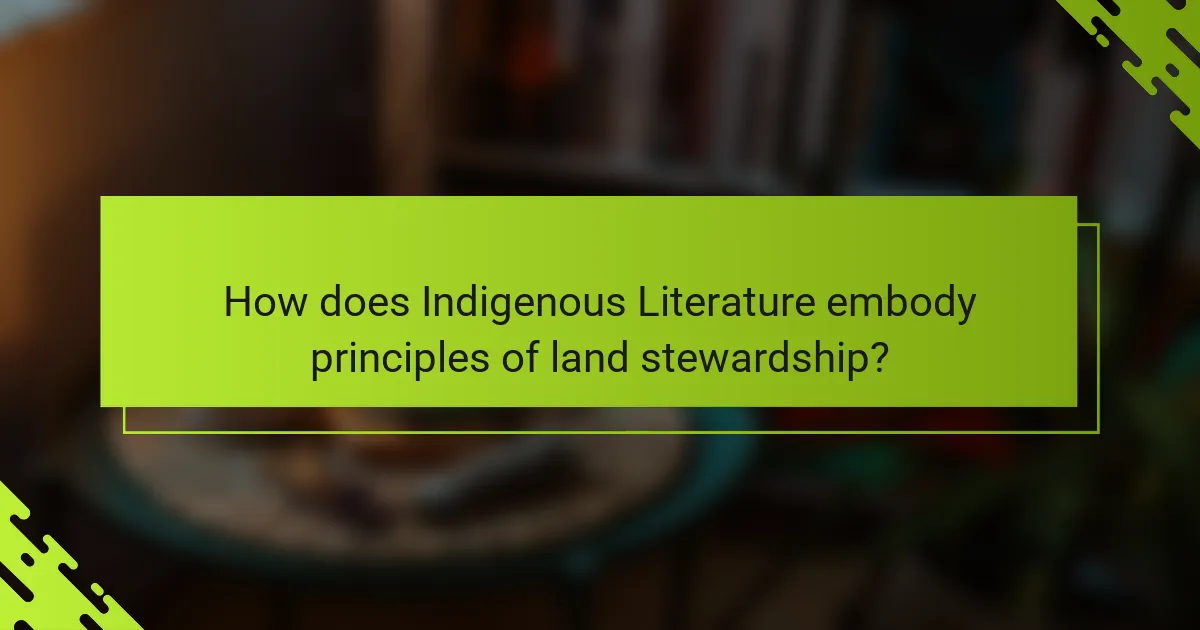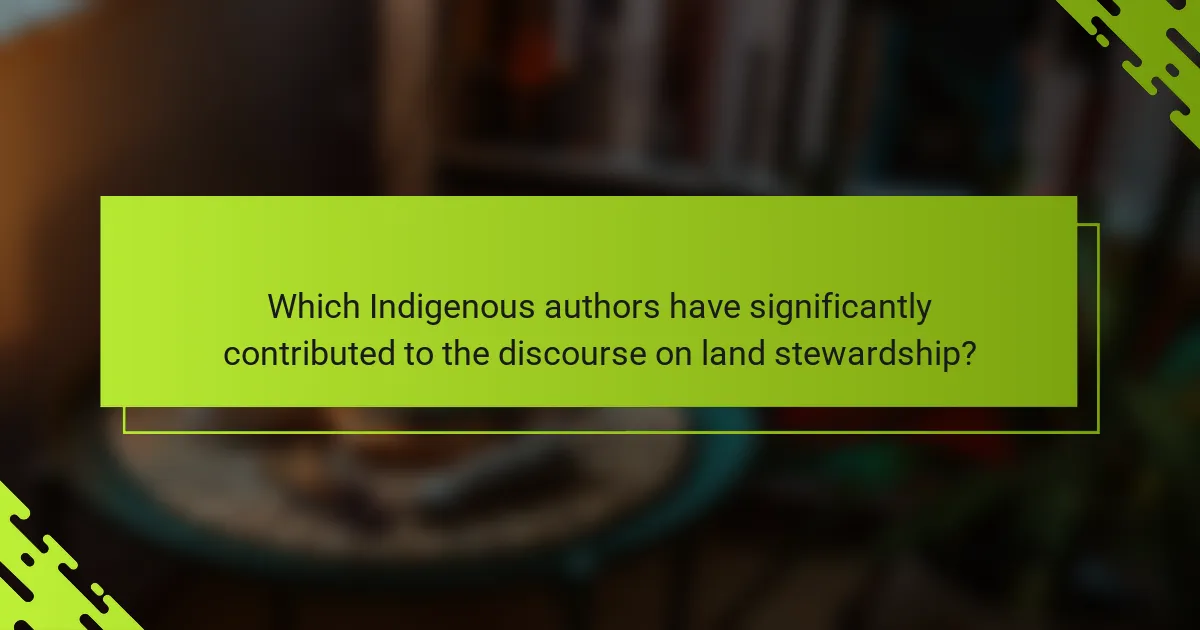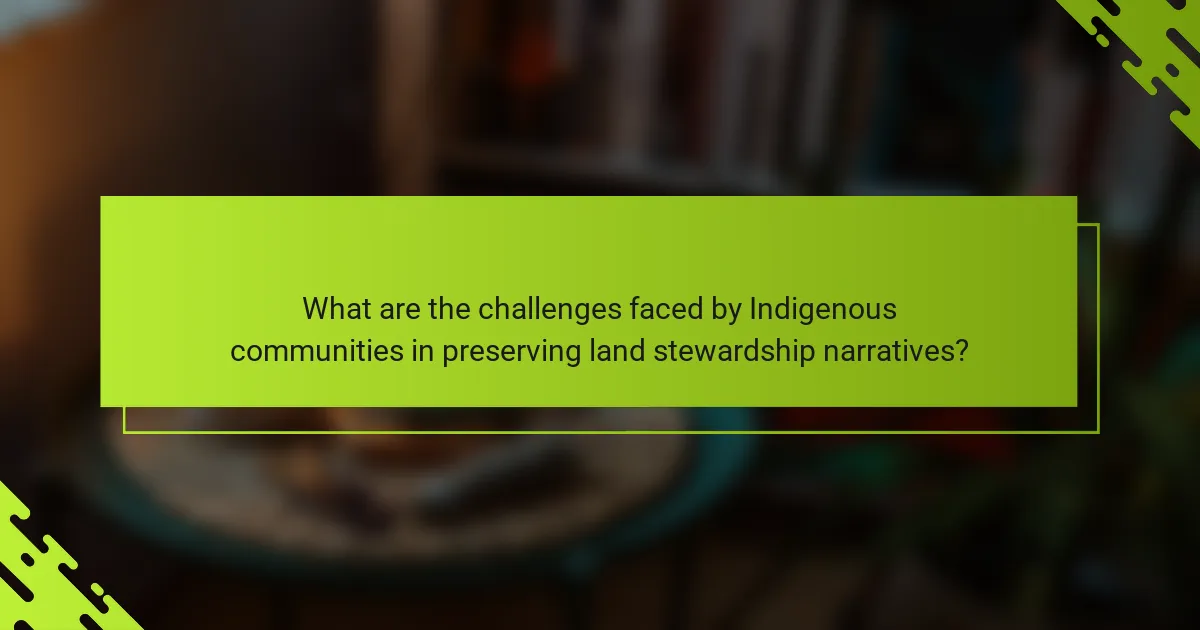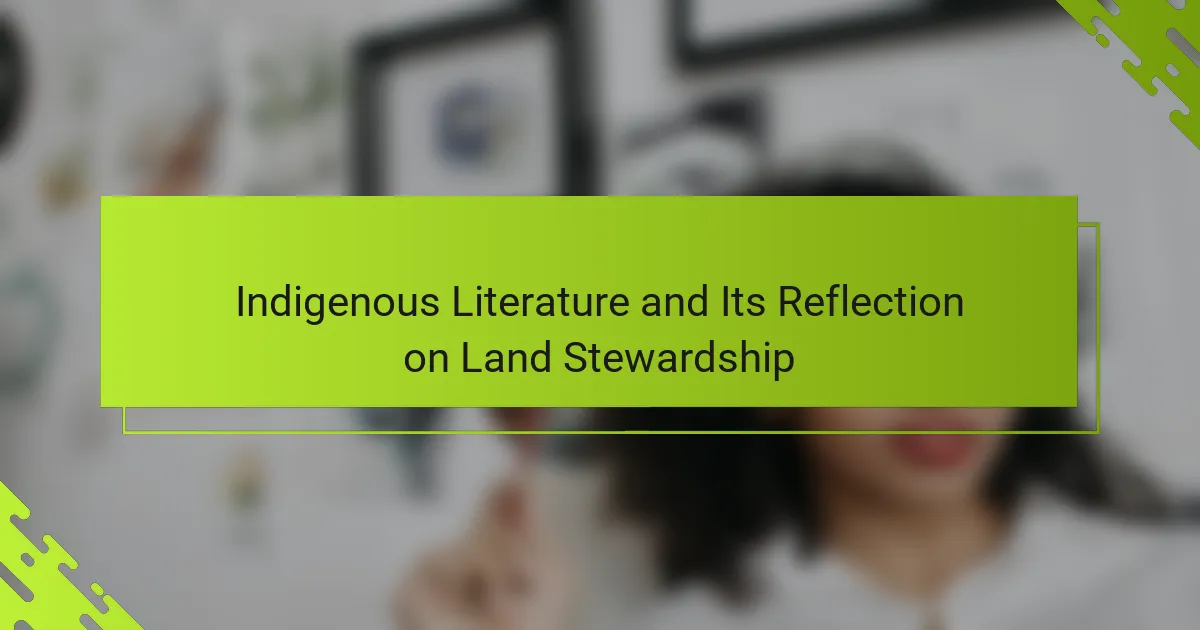Indigenous literature plays a crucial role in highlighting land stewardship principles and the interconnectedness of culture and nature. It showcases traditional ecological knowledge and sustainable practices passed through generations. Prominent authors like Robin Wall Kimmerer and Leanne Betasamosake Simpson illustrate the importance of respecting the land and its resources. Additionally, this literature addresses challenges faced by Indigenous communities in preserving their narratives and emphasizes unique literary forms that express deep connections to the environment.

How does Indigenous Literature embody principles of land stewardship?
Indigenous literature embodies principles of land stewardship by emphasizing interconnectedness with nature. It reflects the belief that land is a living entity deserving respect and care. This literature often illustrates traditional ecological knowledge, showcasing sustainable practices passed through generations. For example, stories may highlight the importance of biodiversity and the responsibility to maintain ecological balance. By weaving these principles into narratives, Indigenous authors advocate for a holistic approach to environmental stewardship, urging readers to recognize their role in protecting the land.
What are the key themes in Indigenous Literature related to land?
Indigenous literature emphasizes land stewardship as a core theme, reflecting deep connections to land. It showcases the spiritual, cultural, and ecological significance of land, often portraying it as a living entity deserving respect.
Stories frequently illustrate traditional ecological knowledge, highlighting sustainable practices that honour ancestral relationships with the environment. This literature advocates for land rights and emphasizes the importance of preserving ecosystems for future generations.
Unique attributes include the incorporation of oral traditions, which convey historical narratives and teachings about land management. Rare themes may address contemporary issues like climate change, emphasizing the need for Indigenous voices in environmental discussions.
Overall, Indigenous literature serves as a powerful medium for expressing the intrinsic value of land and advocating for its stewardship.
How do narratives reflect Indigenous relationships with the environment?
Narratives in Indigenous literature profoundly reflect relationships with the environment by emphasizing interconnectedness and stewardship. These stories often illustrate the sacredness of land, highlighting cultural practices that promote sustainability. For instance, many narratives convey traditional ecological knowledge, showcasing how Indigenous communities manage natural resources through careful observation and respect for nature. This literature serves as a medium for passing down wisdom, reinforcing the idea that caring for the land is essential for future generations. Through these narratives, Indigenous perspectives on environmental relationships challenge dominant paradigms and advocate for a holistic view of nature’s role in human life.

Which Indigenous authors have significantly contributed to the discourse on land stewardship?
Prominent Indigenous authors significantly contributing to land stewardship discourse include Robin Wall Kimmerer, Leanne Betasamosake Simpson, and Thomas King. Their works emphasize the interconnectedness of culture, land, and environmental ethics.
Robin Wall Kimmerer’s “Braiding Sweetgrass” merges Indigenous knowledge with scientific understanding, advocating for reciprocity with nature. Leanne Betasamosake Simpson’s writings reflect on the importance of Indigenous narratives in environmental stewardship. Thomas King’s storytelling critiques colonial perspectives on land and promotes a deeper appreciation of Indigenous relationships with the environment.
These authors collectively highlight the importance of traditional ecological knowledge in contemporary discussions about land stewardship, emphasizing sustainable practices rooted in Indigenous cultures. Their contributions foster a broader understanding of environmental responsibility and the significance of honouring land.
What unique perspectives do these authors offer?
Indigenous authors offer unique perspectives by intertwining narratives of land stewardship with cultural identity. Their works emphasize the intrinsic connection between people and the land, showcasing sustainable practices rooted in tradition. For example, many highlight the importance of biodiversity and ecological balance, reflecting a holistic understanding of environmental stewardship that contrasts with industrial approaches. This perspective fosters a deeper appreciation for Indigenous knowledge systems, which prioritise long-term ecological health over short-term gains.
How have their works influenced contemporary environmental movements?
Indigenous literature has profoundly influenced contemporary environmental movements by emphasizing land stewardship and cultural connections to nature. These works advocate for sustainable practices and highlight the importance of preserving ecosystems. For instance, narratives often illustrate the consequences of environmental degradation, fostering awareness and activism. Indigenous authors inspire movements by sharing traditional ecological knowledge, promoting a holistic understanding of the relationship between people and the land. Their unique perspectives challenge prevailing environmental policies, urging a shift towards more inclusive and respectful approaches to nature.

Why is land stewardship a critical theme in Indigenous Literature?
Land stewardship is critical in Indigenous literature as it reflects deep connections to nature and cultural identity. Indigenous narratives often emphasize sustainable practices that honour the land, showcasing a unique relationship that contrasts with exploitative approaches. This stewardship is rooted in ancestral knowledge and traditions, which advocate for respect and responsibility towards the environment. As a result, Indigenous literature serves as a vital medium for expressing these values and advocating for ecological preservation.
How does land stewardship relate to cultural identity and heritage?
Land stewardship is deeply intertwined with cultural identity and heritage, especially in Indigenous literature. This literature often emphasizes the connection between people and their land, illustrating how stewardship practices shape cultural narratives and community values.
Indigenous narratives reflect a unique attribute of land stewardship, showcasing sustainable practices that have been passed down through generations. These practices foster a sense of belonging and identity, reinforcing the idea that land is not merely a resource but a living entity intertwined with cultural heritage.
Moreover, Indigenous literature often critiques contemporary environmental practices, highlighting the rare attribute of traditional ecological knowledge. This knowledge emphasizes the importance of maintaining balance and respect for the land, which is essential for cultural survival and continuity.
In summary, land stewardship in Indigenous literature serves as a vital expression of cultural identity and heritage, illustrating the deep-rooted relationship between communities and their environments.
What role does storytelling play in promoting environmental awareness?
Storytelling significantly enhances environmental awareness by connecting people to land stewardship through Indigenous literature. This genre emphasizes the relationship between communities and their environment, fostering respect and responsibility. Indigenous narratives often highlight the unique attributes of specific ecosystems, illustrating their importance for cultural identity and sustainability. As a result, these stories serve as powerful tools for educating audiences about ecological preservation and the value of biodiversity. By weaving traditional knowledge with contemporary environmental issues, Indigenous literature promotes a deeper understanding of stewardship practices essential for future generations.

What are the challenges faced by Indigenous communities in preserving land stewardship narratives?
Indigenous communities face numerous challenges in preserving land stewardship narratives. These challenges include loss of traditional knowledge, external pressures from development, and cultural disconnection.
Loss of traditional knowledge occurs as elders pass away without transferring their wisdom. External pressures from industries, such as mining and logging, threaten sacred lands. Cultural disconnection arises when younger generations migrate to urban areas, diminishing their ties to the land.
Furthermore, legal barriers often complicate land rights, making it difficult for communities to assert their stewardship. These factors collectively undermine the narratives that reflect Indigenous relationships with the land.
How do modern legal and political issues impact these narratives?
Modern legal and political issues significantly influence Indigenous literature’s portrayal of land stewardship. These narratives reflect struggles for land rights, environmental justice, and cultural preservation.
Contemporary legal battles often centre on treaties and land claims, shaping the stories Indigenous authors tell. For instance, the recognition of land as a living entity is a common theme, emphasizing the connection between culture and environment.
Political movements advocating for Indigenous sovereignty also impact these narratives. Authors often use literature to critique colonial policies and assert their rights to land management. This engagement fosters a deeper understanding of stewardship rooted in Indigenous knowledge systems.
Overall, the intersection of legal and political contexts enriches Indigenous literature, making it a vital medium for expressing the complexities of land stewardship.
What are the effects of climate change on Indigenous land stewardship practices?
Climate change negatively impacts Indigenous land stewardship practices by disrupting traditional ecological knowledge and altering ecosystems. As temperatures rise, weather patterns shift, affecting resource availability and biodiversity. This threatens the cultural connection to the land and challenges sustainable practices. Indigenous communities may face increased difficulty in maintaining their stewardship roles, as climate change exacerbates existing environmental stresses. For instance, changes in seasonal patterns can lead to diminished harvests, impacting food security and cultural practices tied to land use.

Which rare literary forms are used in Indigenous Literature to express land stewardship?
Rare literary forms in Indigenous Literature, such as oral traditions, poetry, and storytelling, effectively express land stewardship. These forms convey deep connections to the land, emphasizing its sacredness and the responsibilities tied to its care. Oral traditions preserve ecological knowledge, while poetry often reflects the emotional ties to nature. Storytelling serves to pass down ancestral wisdom, reinforcing community values around land stewardship.
What are the characteristics of oral traditions in this context?
Oral traditions in Indigenous literature emphasize storytelling, community engagement, and cultural continuity. These narratives often reflect deep connections to land and stewardship practices. They are characterized by their intergenerational transmission, adaptability, and incorporation of local ecological knowledge. Oral traditions serve as a means to convey values, history, and environmental wisdom, fostering a sense of identity and responsibility towards the land.
How do visual arts complement literary expressions of land stewardship?
Visual arts enhance literary expressions of land stewardship by providing vivid imagery and emotional depth. Indigenous literature often reflects the interconnectedness of nature and culture. Through visual storytelling, artists convey themes of respect, responsibility, and reciprocity towards the land. This synergy fosters a deeper understanding of environmental stewardship and cultural identity. For example, artwork depicting traditional practices reinforces the narratives found in literature, creating a holistic approach to land stewardship.

How can readers engage with Indigenous Literature for better understanding of land stewardship?
Readers can engage with Indigenous literature to deepen their understanding of land stewardship through various approaches. First, exploring narratives that emphasize the interconnectedness of people and nature reveals Indigenous philosophies on environmental care. These stories often highlight sustainable practices and respect for natural resources.
Second, attending readings or discussions led by Indigenous authors fosters direct engagement with the cultural context of the literature. This interaction enriches comprehension of land stewardship principles rooted in Indigenous traditions.
Third, participating in community initiatives inspired by Indigenous literature promotes active learning and application of stewardship practices. Such involvement can lead to a more profound appreciation of ecological balance and responsibility.
Lastly, incorporating educational resources that analyze Indigenous texts encourages critical thinking about land relationships. This approach helps readers recognize the unique attributes of Indigenous perspectives on sustainability and environmental ethics.
What are the best practices for approaching Indigenous texts?
To approach Indigenous texts effectively, prioritise respect for cultural context and knowledge systems. Engage with the material through a lens of stewardship, recognizing the deep connection between Indigenous literature and land.
Reading should be accompanied by understanding the historical and contemporary significance of the land represented in the texts. Consider how narratives reflect Indigenous relationships with nature, emphasizing sustainability and community.
Collaborate with Indigenous voices for authentic interpretations and insights. This practice fosters a deeper appreciation of the literature and its role in advocating for environmental stewardship.
Which resources can enhance appreciation and comprehension of these works?
Resources that enhance appreciation and comprehension of Indigenous literature include critical essays, community workshops, and cultural storytelling events. These resources provide context, foster connections, and highlight the relationship between land stewardship and Indigenous narratives.
1. Critical Essays: Analyze themes and cultural significance in Indigenous literature.
2. Community Workshops: Engage with Indigenous authors and learn about their perspectives.
3. Cultural Storytelling Events: Experience oral traditions that emphasize land and stewardship.
4. Documentaries: Visualize the connection between Indigenous communities and their land.
5. Academic Journals: Provide scholarly insights into Indigenous literary studies.
6. Online Platforms: Offer access to a wide range of Indigenous literary works and discussions.
What common mistakes should be avoided when interpreting Indigenous Literature?
Avoiding common mistakes in interpreting Indigenous literature is essential for understanding its connection to land stewardship. Misinterpretations often stem from overlooking cultural context, imposing external frameworks, and neglecting the significance of oral traditions.
One major mistake is ignoring the specific cultural narratives tied to land. Each Indigenous community has unique stories that reflect their relationship with the environment. Failing to recognize these narratives can lead to a superficial understanding of the literature.
Another error is applying Western literary analysis techniques without considering Indigenous perspectives. This can distort the intended messages and diminish the literature’s depth.
Lastly, disregarding the role of community in storytelling can undermine the collective wisdom embedded in these works. Indigenous literature often emphasizes communal values and responsibilities towards land, which are crucial for accurate interpretation.
